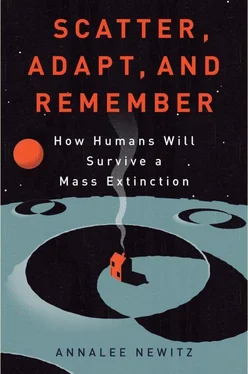Regardless of what the original population was, marine biologists who study the whales seem to agree that the California grays have rebounded in an extraordinary fashion. Over the past 60 years, they’ve gone from near extinction to a healthy, diverse group capable of learning new migratory strategies to cope with changing conditions in the Arctic. Their growing population numbers stand in stark contrast to those of other whales, especially ones like the right whale, humpback, and blue whale that navigate their own great migrations every year. Several studies suggest that noise pollution in the water from radar, and human encroachment into their territories, may be disorienting these whales. This leaves them vulnerable to beaching, or injuring themselves by swimming straight into large ships.
Grays were saved from extinction because humans chose to change their behavior. It’s possible that humans might save other whales from extinction, too, by changing our behavior in the same way. We could avoid using frequencies that whales prefer for their sonar. Or we could track whale migratory patterns using satellites—something that many scientists do already—and avoid creating shipping lanes near the areas where whales are making their journeys. Changing the way we use sonar is obviously more difficult than outlawing whale hunting. But it is certainly possible, and today’s gray whale population is a reminder that extinction is not inevitable for these massive sea mammals.
There’s another reason grays are good survivors, though. Their migratory patterns keep them relatively safe and well fed. Few animals compete with them for food in their Arctic Ocean hunting grounds, which are vast and well stocked. Humpbacks, by contrast, feed in a small coastal area, which Harvey calls “a very compressed region.” If they can’t find prey in that region, humpbacks suffer. But the grays have found an enormous feeding ground where they can chomp on the seafloor during summer, as well as a protected place to mate in winter. And they’ve carefully charted a route between the two places that’s as safe as possible. Traveling along the coasts, their large bodies are generally hidden from predators by the sounds of the surf and the dirty, silty water they love. Their lack of sonar may mean that grays are more solitary, simple creatures than some other cetaceans. But this simplicity has helped them rebound from extinction, while whales with more complex communication and social structures are suffering.
Still, the grays would never have made it this far without their ability to pass along a survival map from one generation to the next. As long as they keep learning new ways to survive the arduous Pacific coastal migration, the grays will endure.
Nomadic humans survived for thousands of years in a similar way, wandering across vast regions to find food and good seasonal weather. Many human tribal groups had traditions where they met once or twice each year for large gatherings, not unlike what the grays do when they converge in the Mexican lagoons. At these gatherings, nomadic humans would exchange gifts, pass on stories, and find people to marry outside their bands. Today, however, human survival can’t hinge on migratory patterns. Most humans live in settled communities and cities, and the knowledge we pass on to the next generation is infinitely more complex than a migratory route or information about where to find the most abundant food. We’ve learned so much that we need libraries and databases to augment our memories.
Still, the grays have a lesson to teach us about the role of memory in survival. This struck me forcefully one afternoon in Monterey Bay, when I joined a whale-watching group in a small boat that fought its way over wind-whipped waves in search of the elusive migrating grays. The most adventurous of us made our way to the bow with our cameras, clinging to the railings and getting completely soaked by spray. We were joined by several large schools of porpoises. A group of four kept jumping out of the waves at the same time in graceful synchrony, as if trying to make it clear to the ridiculous monkeys who really belonged out here. But we kept scanning the horizon for grays, hoping to see their characteristic spouts. At last, just when we were about to retreat, we spotted one. The whale slid its blowhole just above the waves, most of its great bulk obscured by water and distance, and disappeared again. We all jumped up and down, pointing and forgetting to take pictures in our excitement. Just the sight of such a magnificent creature filled us with crazy awe, and all the sopping people in the bow started bonding and swapping stories of other amazing animals we’d seen. One person had seen a Bengal tiger in the wild, and another had been in Mexico to see the grays in their winter home. Nobody forgets these kinds of sightings because most of us, no matter how much we love urban life and civilization, also deeply love nature.
Like grays, humans are good survivors because we’ve learned to find food and homes across a vast region of the planet. Also like grays, we’ve learned to traverse these territories in more efficient ways, responding to changes in the environment. We’ve figured out how to build cities that protect us better than villages did; we’ve passed along stories of how to survive best on what is still a dangerous planet. Sometimes, we’ve even changed our behavior to protect life-forms other than ourselves. As we turn to the next part of this book, about planning for the future, we’re going to remember the grays’ lesson: You’re always coming home, but the path to get there is going to change all the time.
13. PRAGMATIC OPTIMISM, OR STORIES OF SURVIVAL
IN THE PREVIOUS three chapters, we’ve zeroed in on strategies that have helped three different life-forms—humans, cyanobacteria, and gray whales—survive in extremely adverse conditions. We learned how an ancient tribe of humans, today called Jews, lived by scattering and founding new communities in the face of war and oppression. We explored how cyanobacteria’s ability to generate its own form of sustainable energy has made it perhaps the most adaptable life-form on Earth. And we followed a group of gray whales on their difficult migration down the eastern Pacific coast, a journey each whale has memorized in order to survive, and even to bounce back from extinction once humans agreed to stop hunting them. By passing along stories about these survivors, we learn what it would take for humans to survive, too. But some stories about survival are more helpful than others.
In part two, we explored the role symbolic communication played in human evolution. Storytelling could be called the cultural backbone of human survival. There’s a reason that conquering armies often burn the books and libraries of their enemies. Extinguishing a people’s stories is a way of erasing their future. But when we remember those stories, they can steer us in a direction that leads away from death. In fact, stories about how humans might live in the future—sometimes known as science fiction—may be among the most important survival tools we have. We can use these stories as a highly symbolic version of the migration maps that gray whales pass on to the next generation. Futuristic stories offer possible pathways our species can take if we want our progeny to thrive for at least another million years.
What Makes Us Want to Survive?
One of the twentieth century’s greatest science-fiction writers, Octavia Butler, told Essence magazine, “To try to foretell the future without studying history is like trying to learn to read without bothering to learn the alphabet.” Butler grew up during the height of the space race in the 1950s, surrounded by hopeful stories about how humans would colonize the Moon, Mars, and beyond. But her life as the intensely shy daughter of a maid wasn’t exactly Forbidden Planet material. Butler’s mother was a widow who had no home of her own—instead, she and Butler lived in the home of her employers, a white family where Butler recalled visitors making casually racist remarks as if she and her mother weren’t in the room. As an adult, Butler always expressed great admiration for her mother’s tireless efforts to survive, to keep going, despite the many barriers in her way.
Читать дальше






![Аннали Ньюиц - Автономность [litres]](/books/424681/annali-nyuic-avtonomnost-litres-thumb.webp)





